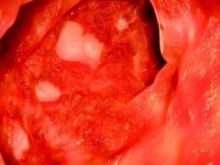Among patients with ulcerative colitis (UC), narrow-band imaging colonoscopy with targeted and segmental biopsy specimens was faster, needed fewer specimens, and was as sensitive for detecting intraepithelial neoplasias as white light colonoscopy with targeted and stepwise sampling, researchers reported.
“Our study shows the high yield of stepwise random biopsy specimens in long-standing colitis,” Dr. Ludger Leifeld of the department of internal medicine at Evangelisches Krankenhaus Kalk in Cologne, Germany, and his associates wrote in the October issue of Clinical Gastroenterology and Hepatology. “The highest sensitivity should be reached by combining the white light and narrow-band imaging techniques by switching between the modes.”
Ulcerative colitis increases colorectal cancer risk, and detecting lesions early can be lifesaving. But the best technique for colonoscopy in UC remains controversial, the investigators noted. Therefore, they prospectively studied 159 adults with left-sided UC diagnosed at least 15 years earlier who were in clinical remission and had not undergone partial colectomy. Each patient underwent both narrow-band imaging and white light colonoscopy separated by 3 weeks to 3 months. In addition to targeted sampling, white-light colonoscopists took four predefined biopsy specimens every 10 cm, as well as two biopsy specimens in each of the five segments of the colon. Narrow-band imaging procedures only involved taking targeted and segmental biopsy specimens (Clin Gastro Hepatol. doi: 10.1016/j.cgh.2015.04.172).
Overall, colonoscopy detected dysplastic lesions in more than 22% of patients, the researchers reported. The narrow-band method identified similar numbers of intraepithelial cancers as white light, but required an average of only 11.9 specimens per patient – less than one-third as many as white light (38.6; P less than .001), the investigators said. Furthermore, withdrawal times averaged only 13 minutes for narrow-band imaging, compared with 23 minutes for white light colonoscopy (P less than .001). The two techniques had similar miss rates, according to the researchers.
Notably, 37% of intraepithelial neoplasias that were detected by white light colonoscopy came from stepwise random biopsy specimens, said the investigators. “The idea to take random biopsy specimens is ignored by many endoscopists, which limits the sensitivity of those colonoscopies,” they emphasized. “The sensitivity of stepwise random biopsy specimens could be increased further by adding 10 more segmental random biopsy specimens, which uncovered an additional 13% of lesions,” they added. Fourteen of these 15 lesions were non–adenomalike, showing the importance of random biopsy specimens, especially for detecting nonadenoma lesions, they said.
“When the white light technique is used, stepwise biopsy specimens are indispensable,” the investigators concluded. For narrow-band imaging technology, “combining targeted biopsy specimens … with 10 segmental biopsy specimens is an equipotent alternative to targeted biopsy specimens using white light in addition to four biopsy specimens every 10 cm. However, [the narrow-band] approach significantly saves time and numbers of biopsy specimens, which should have positive effects on feasibility, costs, and endoscopist compliance.”
The study was funded by Deutsche Morbus Crohn/Colitis Ulcerosa Vereinigung, the Working Group for Endoscopic Research of the DGVS, and the Kurscheid Foundation, and Olympus Medical. The authors reported having no conflicts of interest.


